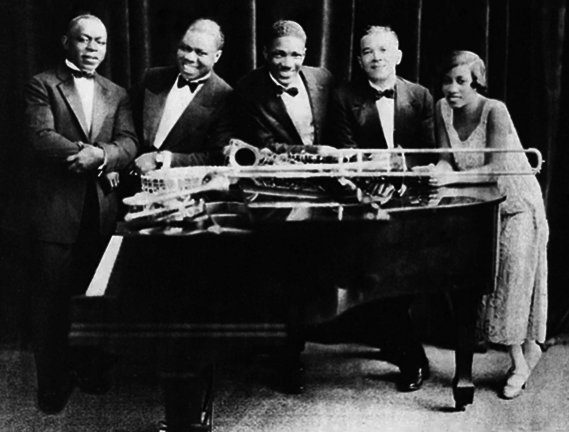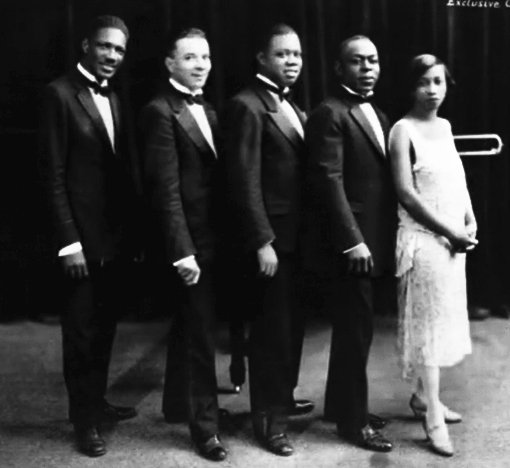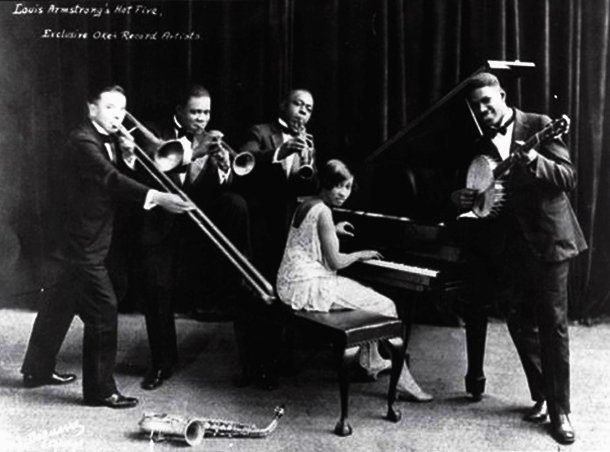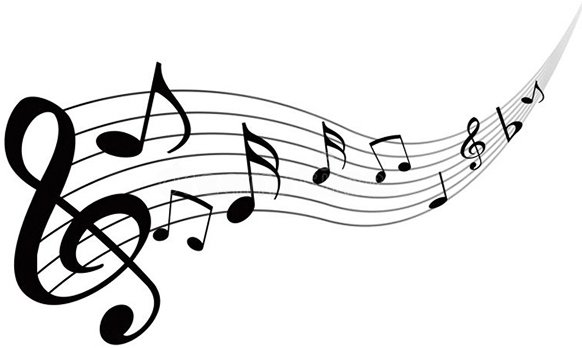Cornet Chop Suey
Louis Armstrong and His Hot Five: Louis Armstrong (trompeta), Kid Ory (trombón), Johnny Dodds (clarinete), Lil Hardin Armstrong (piano) y Johnny St. Cyr (banyo) (1926).
Al principio, la música del Louis Armstrong and His Hot Five seguía la tradición original del jazz basada en la improvisación colectiva, pero debido a la gran creatividad que Armstrong mostraba con la trompeta, sus solos fueron apareciendo cada vez con más frecuencia, y en ellos estableció el lenguaje básico de la improvisación solista en el jazz. El estilo Chicago liberó al solista de las cadenas de la improvisación contrapuntística y permitió que otros instrumentos principales tuvieran mayor libertad para crear líneas melódicas. Además, el ritmo de dos tiempos en el que se basaba el jazz más antiguo pasó a ser de cuatro tiempos, sustituyendo el sousafón por el contrabajo para proporcionar las líneas de bajo.
At first, the music of the Louis Armstrong and His Hot Five followed the original jazz tradition based on collective improvisation, but due to the great creativity that Armstrong showed with the trumpet, his solos appeared more and more frequently, and in them he laid down the basic language of solo improvisation in jazz. The Chicago style liberated the soloist from the chains of contrapuntal improvisation and allowed other leading instruments, giving greater freedom to create melodic lines. Also the two-beat rhythm in which the older jazz was based changed to four-beat replacing the sousaphone with the double bass to provide the bass lines.
 Louis Armstrong & His Hot Five
Louis Armstrong & His Hot Five
Armstrong es el segundo empezando por la izquierda
Fuente
Armstrong utilizó esta nueva libertad para acentuar los segundos y cuartos tiempos y anticiparse a los tiempos principales con notas de entrada en sus solos para crear una sensación de pulso rítmico que se producía tanto entre los tiempos como sobre ellos, dando lugar a lo que se denominó «síncopa» y más tarde «swing». Con su complejidad armónica, su virtuoso registro y su empuje con la trompeta, se estableció firmemente como el principal innovador de la música. Esto es puede escuchar con claridad en «Cornet Chop Suey» y en «Struttin’ with Some Barbecue», que se encuentran a continuación.
Armstrong used the new freedom to accentuate the second and fourth beats and anticipating the main beats with lead-in notes in his solos to create a sense of rhythmic pulse that happened between the beats as well as on them, giving rise to what was then called “syncopation” and later on “swing”. With his harmonic complexity, his virtuoso range and his drive on the trumpet, he firmly established himself as the foremost innovator of the music. This is clearly heard in “Cornet Chop Suey” and “Struttin’ with Some Barbecue”, which can be found below.
 Louis Armstrong & His Hot Five
Louis Armstrong & His Hot Five
Armstrong es el tercero empezando por la izquierda
Fuente
En mayo de 1927 organizó los Louis Armstrong and His Hot Seven añadiendo a Pete Briggs a la tuba y a Baby Dodds (hermano del clarinetista) a la batería. Además, John Thomas sustituyó a Kid Ory al trombón, who was touring at the time with King Oliver. Esto fue posible gracias a que el sello Okeh empezó a realizar grabaciones eléctricas en lugar de acústicas. Durante aquel mes grabaron doce temas, incluyendo el canción de vodevil estándar «Willie the Weeper», los ragtime «Twelfth Street Rag» y «Weary blues», además del éxito «Potato Head Blues», escrito por el propio Armstrong. En estos temas Armstrong perfeccionó su dominio del solo de jazz convirtiendo el estilo de jazz de Nueva Orleans en un vehículo para el solista.
In May 1927 he organized the Louis Armstrong and His Hot Seven by adding Pete Briggs on tuba and Baby Dodds (brother of the clarinetist) on drums. Additionally, John Thomas replaced Kid Ory on trombone, who was touring at the time with King Oliver. This was possible because the Okeh label began making electrical recordings rather than acoustic ones. During that month they recorded twelve tracks, including the standard vaudeville song “Willie the Weeper”, the ragtime “Twelfth Street Rag” and “Weary Blues”, as well as the hit “Potato Head Blues”, written by Armstrong himself. Please, find all of them below. On these tunes Armstrong refined his mastery of the jazz solo further cracking the New Orleans jazz style into a vehicle for the soloist.
 Louis Armstrong & His Hot Five
Louis Armstrong & His Hot Five
Armstrong es el segundo empezando por la izquierda
Fuente
Translated with the help of DeepL
Fuente

Willie The Weeper
Louis Armstrong and His Hot Seven: Louis Armstrong (trompeta), John Thomas (trombón), Johnny Dodds (clarinete), Lil Hardin Armstrong (piano), Johnny St. Cyr (banyo) y «Baby» Dodds (batería) (1926).
Fuente

Twelfth Street Rag
Louis Armstrong and His Hot Seven: Louis Armstrong (corneta, voz), John Thomas (trombón), Johnny Dodds (clarinete), Lil Hardin Armstrong (piano, voz), Johnny St. Cyr (banyo) y «Baby» Dodds (batería) (1926).
Fuente

Weary Blues
Louis Armstrong and His Hot Seven: Louis Armstrong (trompeta), John Thomas (trombón), Johnny Dodds (clarinete), Lil Hardin Armstrong (piano), Johnny St. Cyr (banyo) y «Baby» Dodds (batería) (1926).
Fuente

Potato Head Blues
Louis Armstrong and His Hot Seven: Louis Armstrong (corneta), John Thomas (trombón), Johnny Dodds (clarinete), Lil Hardin Armstrong (piano), Johnny St. Cyr (banyo) y «Baby» Dodds (batería) (1926).










I've never heard of this musical group before.
This is one reason I love to go through publications like this.
I know I'm sure going to come across knowledge like this.
This is really lovely!
¡Enhorabuena!
✅ Has hecho un buen trabajo, por lo cual tu publicación ha sido valorada y ha recibido el apoyo de parte de CHESS BROTHERS ♔ 💪
♟ Te invitamos a usar nuestra etiqueta #chessbrothers y a que aprendas más sobre nosotros.
♟♟ También puedes contactarnos en nuestro servidor de Discord y promocionar allí tus publicaciones.
♟♟♟ Considera unirte a nuestro trail de curación para que trabajemos en equipo y recibas recompensas automáticamente.
♞♟ Echa un vistazo a nuestra cuenta @chessbrotherspro para que te informes sobre el proceso de curación llevado a diario por nuestro equipo.
🥇 Si quieres obtener ganancias con tu delegacion de HP y apoyar a nuestro proyecto, te invitamos a unirte al plan Master Investor. Aquí puedes aprender cómo hacerlo.
Cordialmente
El equipo de CHESS BROTHERS